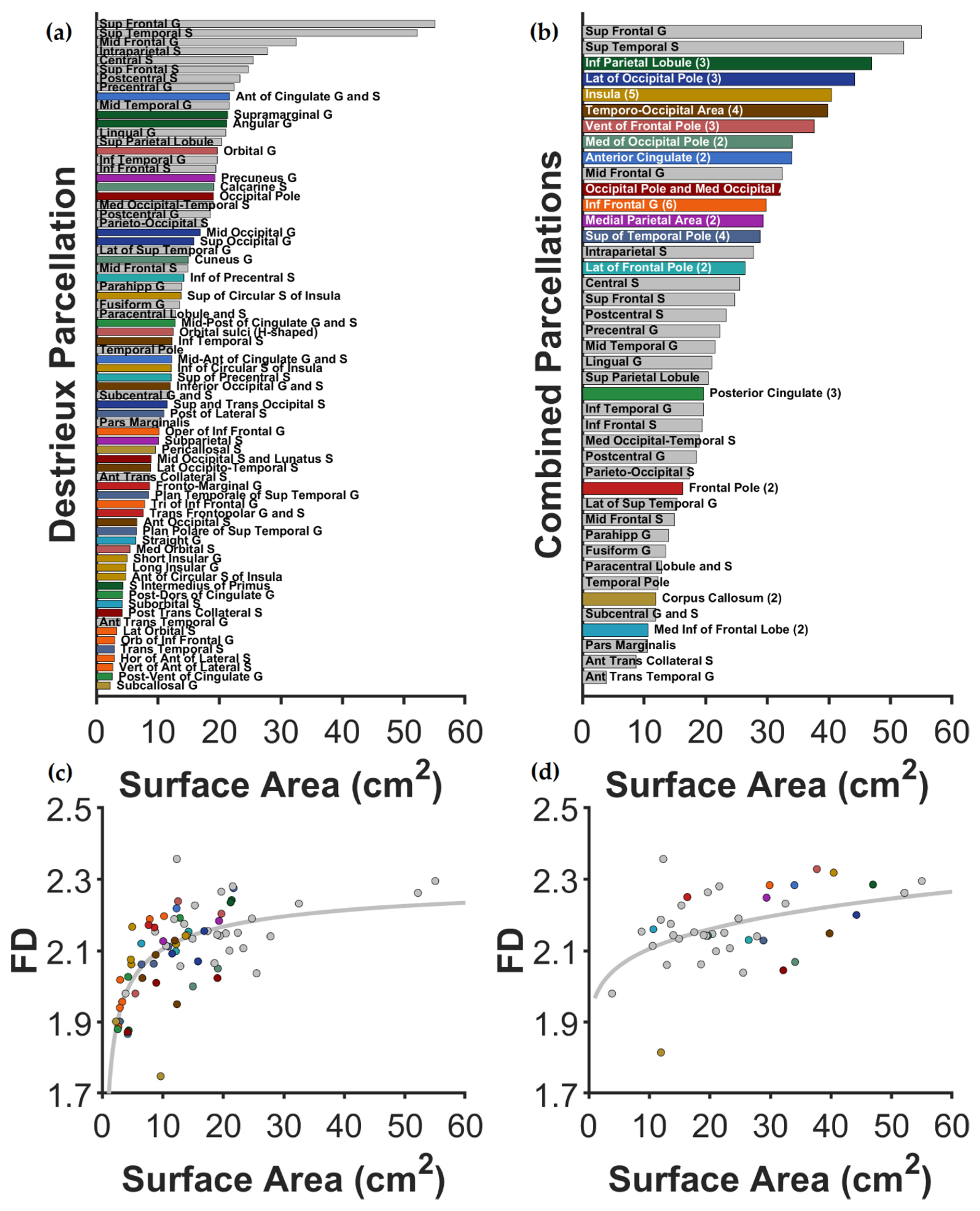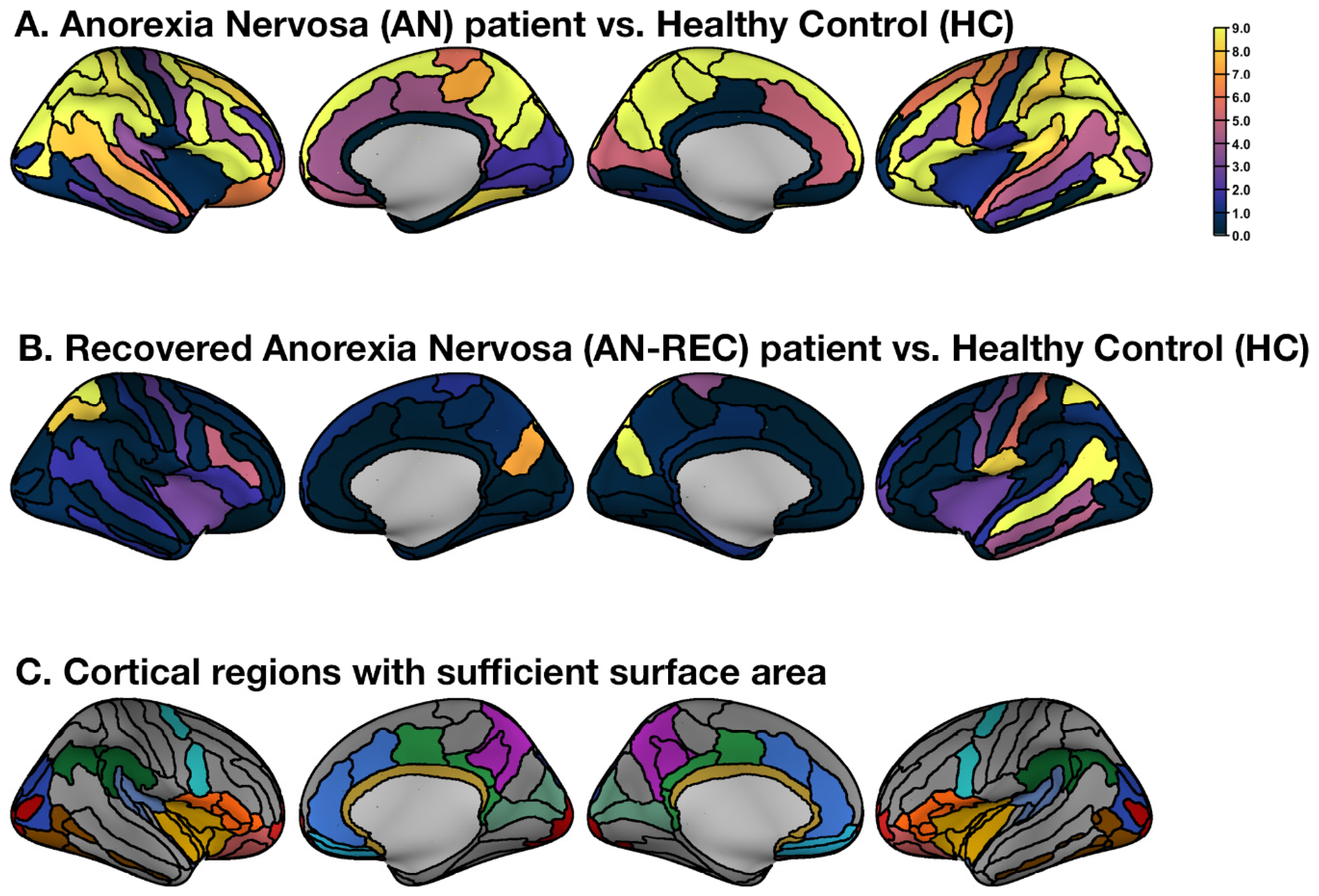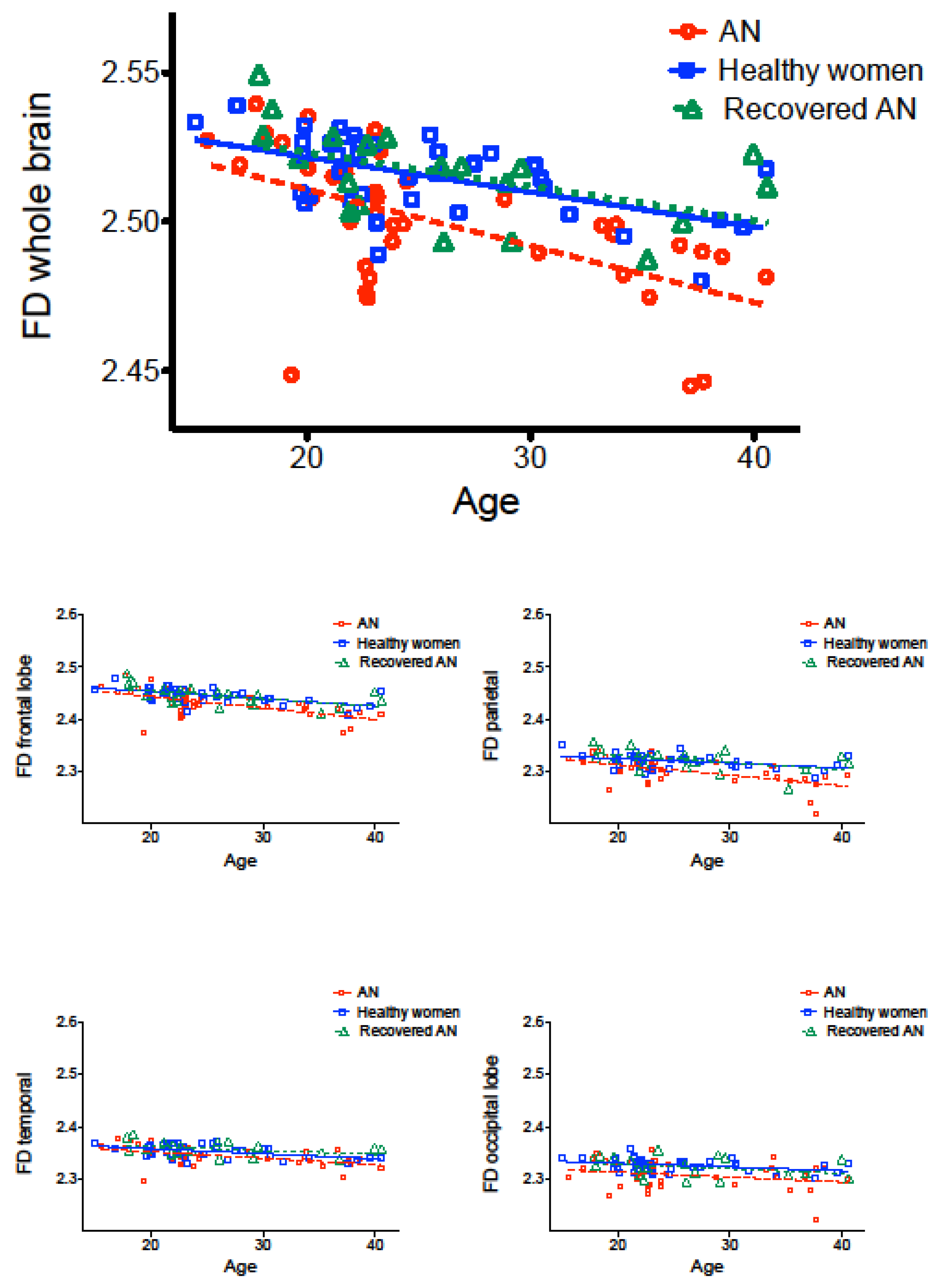Cortical Complexity in Anorexia Nervosa: A Fractal Dimension Analysis
Abstract
1. Introduction
2. Methods
2.1. MRI Data Acquisition
2.2. Data Processing and Statistics
3. Results
4. Discussion
Supplementary Materials
Author Contributions
Conflicts of Interest
References
- Favaro, A.; Caregaro, L.; Tenconi, E.; Bosello, R.; Santonastaso, P. Time trends in age at onset of anorexia nervosa and bulimia nervosa. J. Clin. Psychiatry 2009, 70, 1715–1721. [Google Scholar] [CrossRef]
- Seitz, J.; Bühren, K.; Von Polier, G.G.; Heussen, N.; Herpertz-Dahlmann, B.; Konrad, K. Morphological Changes in the Brain of Acutely Ill and Weight-Recovered Patients with Anorexia Nervosa a Meta-Analysis and Qualitative Review. J. Child Adolesc. Psychiatry Psychother. 2014, 42, 7–18. [Google Scholar]
- Connan, F.; Campbell, I.C.; Katzman, M.; Lightman, S.L.; Treasure, J. A neurodevelopmental model for anorexia nervosa. Physiol. Behav. 2003, 79, 13–24. [Google Scholar] [CrossRef]
- Andersen, S.L. Trajectories of brain development: Point of vulnerability or window of opportunity? Neurosci. Biobehav. Rev. 2003, 27, 3–18. [Google Scholar] [CrossRef]
- Seitz, J.; Herpertz-Dahlmann, B.; Konrad, K. Brain morphological changes in adolescent and adult patients with anorexia nervosa. J. Neural Transm. 2016, 123, 949–959. [Google Scholar] [CrossRef] [PubMed]
- Bernardoni, F.; King, J.A.; Geisler, D.; Stein, E.; Jaite, C.; Nätsch, D.; Tam, F.I.; Boehm, I.; Seidel, M.; Roessner, V.; et al. Weight restoration therapy rapidly reverses cortical thinning in anorexia nervosa: A longitudinal study. Neuroimage 2016, 130, 214–222. [Google Scholar] [CrossRef] [PubMed]
- Lavagnino, L.; Amianto, F.; Mwangi, B.; D’Agata, F.; Spalatro, A.; Zunta Soares, G.B.; Daga, G.A.; Mortara, P.; Fassino, S.; Soares, J.C. The relationship between cortical thickness and body mass index differs between women with anorexia nervosa and healthy controls. Psychiatry Res. Neuroimaging 2016, 248, 105–109. [Google Scholar] [CrossRef]
- Collantoni, E.; Meneguzzo, P.; Tenconi, E.; Manara, R.; Favaro, A. Small-world properties of brain morphological characteristics in Anorexia Nervosa. PLoS ONE 2019, 14, e0216154. [Google Scholar] [CrossRef] [PubMed]
- Fuglset, T.S.; Endestad, T.; Hilland, E.; Bang, L.; Tamnes, C.K.; Landrø, N.I.; Rø, Ø. Brain volumes and regional cortical thickness in young females with anorexia nervosa. BMC Psychiatry 2016, 16, 404. [Google Scholar] [CrossRef] [PubMed]
- Favaro, A.; Tenconi, E.; Degortes, D.; Manara, R.; Santonastaso, P. Gyrification brain abnormalities as predictors of outcome in anorexia nervosa. Hum. Brain Mapp. 2015, 36, 5113–5122. [Google Scholar] [CrossRef] [PubMed]
- Schultz, C.C.; Wagner, G.; de la Cruz, F.; Berger, S.; Reichenbach, J.R.; Sauer, H.; Bär, K.J. Evidence for alterations of cortical folding in anorexia nervosa. Eur. Arch. Psychiatry Clin. Neurosci. 2017, 267, 41–49. [Google Scholar] [CrossRef] [PubMed]
- Bernardoni, F.; King, J.A.; Geisler, D.; Birkenstock, J.; Tam, F.I.; Weidner, K.; Roessner, V.; White, T.; Ehrlich, S. Nutritional status affects cortical folding: Lessons learned from anorexia nervosa. Biol. Psychiatry 2018, 84, 692–701. [Google Scholar] [CrossRef] [PubMed]
- White, T.; Su, S.; Schmidt, M.; Kao, C.Y.; Sapiro, G. The development of gyrification in childhood and adolescence. Brain Cogn. 2010, 72, 36–45. [Google Scholar] [CrossRef] [PubMed]
- Kiselev, V.G.; Hahn, K.R.; Auer, D.P. Is the brain cortex a fractal? Neuroimage 2003, 20, 1765–1774. [Google Scholar] [CrossRef]
- Madan, C.R.; Kensinger, E.A. Cortical complexity as a measure of age-related brain atrophy. Neuroimage 2016, 134, 617–629. [Google Scholar] [CrossRef]
- Di Ieva, A. The Fractal Geometry of the Brain: An Overview; Springer: New York, NY, USA, 2016; ISBN 9781493939954. [Google Scholar]
- Mandelbrot, B. How long is the coast of Britain? Statistical self-similarity and fractional dimension. Science 1967, 156, 636–638. [Google Scholar] [CrossRef]
- Hofman, M.A. The fractal geometry of convoluted brains. J. Hirnforsch. 1991, 32, 103–111. [Google Scholar]
- Cook, M.J.; Free, S.L.; Manford, M.R.A.; Fish, D.R.; Shorvon, S.D.; Stevens, J.M. Fractal Description of Cerebral Cortical Patterns in Frontal Lobe Epilepsy. Eur. Neurol. 1995, 35, 327–335. [Google Scholar] [CrossRef]
- Nenadic, I.; Yotter, R.A.; Sauer, H.; Gaser, C. Cortical surface complexity in frontal and temporal areas varies across subgroups of schizophrenia. Hum. Brain Mapp. 2014, 35, 1691–1699. [Google Scholar] [CrossRef]
- Sandu, A.-L.; Rasmussen, I.-A.; Lundervold, A.; Kreuder, F.; Neckelmann, G.; Hugdahl, K.; Specht, K. Fractal dimension analysis of MR images reveals grey matter structure irregularities in schizophrenia. Comput. Med. Imaging Graph. 2008, 32, 150–158. [Google Scholar] [CrossRef]
- King, R.D.; Brown, B.; Hwang, M.; Jeon, T.; George, A.T. Fractal dimension analysis of the cortical ribbon in mild Alzheimer’s disease. Neuroimage 2010, 53, 471–479. [Google Scholar] [CrossRef] [PubMed]
- Madan, C.R.; Kensinger, E.A. Age-related differences in the structural complexity of subcortical and ventricular structures. Neurobiol. Aging 2017, 50, 87–95. [Google Scholar] [CrossRef] [PubMed]
- Ha, T.H.; Yoon, U.; Lee, K.J.; Shin, Y.W.; Lee, J.-M.; Kim, I.Y.; Ha, K.S.; Kim, S.I.; Kwon, J.S. Fractal dimension of cerebral cortical surface in schizophrenia and obsessive–compulsive disorder. Neurosci. Lett. 2005, 384, 172–176. [Google Scholar] [CrossRef] [PubMed]
- Li, X.; Jiang, J.; Zhu, W.; Yu, C.; Sui, M.; Wang, Y.; Jiang, T. Asymmetry of prefrontal cortical convolution complexity in males with attention-deficit/hyperactivity disorder using fractal information dimension. Brain Dev. 2007, 29, 649–655. [Google Scholar] [CrossRef] [PubMed]
- Squarcina, L.; De Luca, A.; Bellani, M.; Brambilla, P.; Turkheimer, F.E.; Bertoldo, A. Fractal analysis of MRI data for the characterization of patients with schizophrenia and bipolar disorder. Phys. Med. Biol. 2015, 60, 1697–1716. [Google Scholar] [CrossRef] [PubMed]
- Zhao, G.; Denisova, K.; Sehatpour, P.; Long, J.; Gui, W.; Qiao, J.; Javitt, D.C.; Wang, Z. Fractal dimension analysis of subcortical gray matter structures in schizophrenia. PLoS ONE 2016, 11, 1–23. [Google Scholar] [CrossRef]
- Nickel, K.; Joos, A.; Tebartz van Elst, L.; Holovics, L.; Endres, D.; Zeeck, A.; Maier, S. Altered cortical folding and reduced sulcal depth in adults with anorexia nervosa. Eur. Eat. Disord. Rev. 2019, 27, 655–670. [Google Scholar] [CrossRef]
- Favaro, A.; Clementi, M.; Manara, R.; Bosello, R.; Forzan, M.; Bruson, A.; Tenconi, E.; Degortes, D.; Titton, F.; Di Salle, F.; et al. Catechol-O-methyltransferase genotype modifies executive functioning and prefrontal functional connectivity in women with anorexia nervosa. J. Psychiatry Neurosci. 2013, 38, 241–248. [Google Scholar] [CrossRef]
- American Psychiatric Association. Diagnostic and Statistical Manual of Mental Disorders; American Psychiatric Association: Virginia, VA, USA, 2013; ISBN 0-89042-555-8. [Google Scholar]
- Favaro, A.; Santonastaso, P.; Manara, R.; Bosello, R.; Bommarito, G.; Tenconi, E.; Di Salle, F. Disruption of visuospatial and somatosensory functional connectivity in anorexia nervosa. Biol. Psychiatry 2012, 72, 864–870. [Google Scholar] [CrossRef]
- Derogatis, L.R.; Lipman, R.S.; Rickels, K.; Uhlenhuth, E.H.; Covi, L. The Hopkins Symptom Checklist (HSCL): A Self Report Symptom Inventory. Behav. Sci. 1974, 19, 1–15. [Google Scholar] [CrossRef]
- Garner, D.M.; Olmstead, M.P.; Polivy, J. Development and validation of a multidimensional eating disorder inventory for anorexia nervosa and bulimia. Int. J. Eat. Disord. 1983, 2, 15–34. [Google Scholar] [CrossRef]
- Oldfield, R.C. The assessment and analysis of handedness: The Edinburgh inventory. Neuropsychologia 1971, 9, 97–113. [Google Scholar] [CrossRef]
- Fischl, B. FreeSurfer. Neuroimage 2012, 62, 774–781. [Google Scholar] [CrossRef] [PubMed]
- Destrieux, C.; Fischl, B.; Dale, A.; Halgren, E. Automatic parcellation of human cortical gyri and sulci using standard anatomical nomenclature. Neuroimage 2010, 53, 1–15. [Google Scholar] [CrossRef]
- Madan, C.R.; Kensinger, E.A. Test–retest reliability of brain morphology estimates. Brain Inform. 2017, 4, 107–121. [Google Scholar] [CrossRef]
- Madan, C.R. Age differences in head motion and estimates of cortical morphology. PeerJ 2018, 6, e5176. [Google Scholar] [CrossRef]
- Benjamini, Y.; Hochberg, Y. Controlling the False Discovery Rate—A Practical and Powerful Approach to Multiple Testing. J. R. Stat. Soc. Ser. B 1995, 57, 289–300. [Google Scholar] [CrossRef]
- Madan, C.R.; Kensinger, E.A. Predicting age from cortical structure across the lifespan. Eur. J. Neurosci. 2018, 47, 399–416. [Google Scholar] [CrossRef]
- Favaro, A. Brain development and neurocircuit modeling are the interface between genetic/environmental risk factors and eating disorders. A commentary on keel & forney and friederich et al. Int. J. Eat. Disord. 2013, 46, 443–446. [Google Scholar]
- Sandu, A.-L.; Izard, E.; Specht, K.; Beneventi, H.; Lundervold, A.; Ystad, M. Post-adolescent developmental changes in cortical complexity. Behav. Brain Funct. 2014, 10, 44. [Google Scholar] [CrossRef]




| AN | AN-REC | HC | AN vs. HC | AN-REC. vs. HC | ||||
|---|---|---|---|---|---|---|---|---|
| (n = 38) | (n = 20) | (n = 38) | ||||||
| Mean | SD | Mean | SD | Mean | SD | Z (p) | Z (p) | |
| Age (years) | 26.1 | 7.2 | 26.3 | 7.0 | 25.2 | 6.7 | 0.38 (0.701) | 0.44 (0.659) |
| Baseline BMI (kg/m2) | 16.0 | 1.8 | 19.6 | 1.6 | 21.6 | 3.0 | 7.42 (0.000) | 3.09 (0.002) |
| Lowest BMI (kg/m2) | 14.0 | 1.8 | 15.7 | 1.4 | 19.8 | 2.5 | 7.17 (0.000) | 5.35 (0.000) |
| Weight loss (kg) | 7.1 | 2.8 | 5.2 | 3.1 | 3.4 | 1.7 | - | - |
| Age of onset (years) | 18.3 | 5.0 | 17.7 | 3.2 | - | - | - | - |
| Duration of illness (months) | 78.6 | 81.2 | 45.7 | 65.0 | - | - | - | - |
| Duration of recovery (months) | 45.4 | 47.0 | - | - | - | - | ||
| Edinburgh laterality index | 57.1 | 37.5 | 60.0 | 35.2 | 55.0 | 42.0 | 0.52 (0.603) | 0.32 (0.749) |
| Education (years) | 14.2 | 2.2 | 14.1 | 2.6 | 15.4 | 2.3 | 2.63 (0.009) | 1.94 (0.053) |
| Drive to thinness | 9.9 | 6.1 | - | - | 2.3 | 4.2 | 5.492 (0.000) | - |
| Depression | 1.4 | 0.8 | - | - | 0.7 | 0.6 | 3.844 (0.000) | - |
| Trait anxiety | 56.6 | 9.7 | - | - | 39.3 | 9.6 | 5.883 (0.000) | - |
| Cortex volume (mm3) | 440,936 | 38,526 | 456,932 | 36,916 | 458,753 | 31,225 | 9.55 (0.003) | 0.07 (0.80) |
| Gyrification Index | 2.85 | 0.09 | 2.90 | 0.09 | 2.90 | 0.11 | 2.09 (0.04) | 0.08 (0.93) |
| Surface area (mm2) | 160,640 | 13,527 | 157,348 | 9381 | 165,082 | 12,113 | 2.20 (0.142) | 6.11 (0.017) |
| Cortical Thickness (mm) | 2.49 | 0.12 | 2.51 | 0.11 | 2.48 | 0.12 | 0.52 (0.14) | 1.05 (0.30) |
| AN | AN-REC | HC | AN vs. HC | AN-REC vs. HC | |
|---|---|---|---|---|---|
| Mean (SD) | Mean (SD) | Mean (SD) | F* (p) | F* (p) | |
| Whole Brain (Cortical Ribbon) | 2.49 (0.02) | 2.52 (0.02) | 2.51 (0.01) | 16.36 (0.000) | 0.32 (0.573) |
| Frontal Lobe | 2.43 (0.02) | 2.44 (0.02) | 2.44 (0.01) | 13.07 (0.001) | 0.05 (0.829) |
| Parietal Lobe | 2.30 (0.02) | 2.32 (0.02) | 2.32 (0.01) | 19.75 (0.000) | 0.72 (0.400) |
| Temporal Lobe | 2.34 (0.02) | 2.36 (0.01) | 2.35 (0.01) | 5.40 (0.023) | 3.46 (0.068) |
| Occipital Lobe | 2.30 (0.02) | 2.32 (0.02) | 2.32 (0.01) | 15.31 (0.000) | 0.55 (0.462) |
| Left Superior Parietal Lobule | 2.13 (0.06) | 2.16 (0.03) | 2.19 (0.04) | 26.956 (0.000) | 8.711 (0.005) |
| Right Superior Parietal Lobule | 2.11 (0.06) | 2.13 (0.04) | 2.16 (0.03) | 23.580 (0.000) | 9.600 (0.003) |
| Left Postcentral Gyrus | 2.06 (0.06) | 2.07 (0.04) | 2.10 (0.04) | 9.851 (0.002) | 5.689 (0.021) |
| Right Intraparietal Sulcus | 2.11 (0.05) | 2.12 (0.04) | 2.15 (0.03) | 18.715 (0.000) | 8.170 (0.006) |
| Left Parieto-Occipital Sulcus | 2.13 (0.04) | 2.13 (0.04) | 2.16 (0.02) | 12.640 (0.001) | 10.339 (0.002) |
| Right Parieto-Occipital Sulcus | 2.15 (0.04) | 2.16 (0.04) | 2.18 (0.03) | 17.123 (0.000) | 7.250 (0.009) |
| AN (n = 38) Rho (p) | AN-REC (n = 20) Rho (p) | Healthy Controls (n = 38) Rho (p) | |
|---|---|---|---|
| Whole-brain FD | |||
| Age | −0.608 (0.000) * | −0.617 (0.004) * | −0.527 (0.001) * |
| Body mass index (BMI) | 0.380 (0.019) * | −0.351 (0.130) | −0.209 (0.207) |
| Duration of illness | −0.406 (0.011) * | −0.111 (0.642) | |
| Age of AN onset | −0.265 (0.108) | −0.586 (0.007) * | |
| Cortical volume | 0.638 (0.000) * | 0.537 (0.015) * | 0.496 (0.002) * |
| Cortical gyrification | 0.258 (0.118) | 0.376 (0.102) | 0.514 (0.001) * |
| Cortical thickness | 0.000 (0.998) | 0.65 (0.787) | 0.025 (0.883) |
© 2020 by the authors. Licensee MDPI, Basel, Switzerland. This article is an open access article distributed under the terms and conditions of the Creative Commons Attribution (CC BY) license (http://creativecommons.org/licenses/by/4.0/).
Share and Cite
Collantoni, E.; Madan, C.R.; Meneguzzo, P.; Chiappini, I.; Tenconi, E.; Manara, R.; Favaro, A. Cortical Complexity in Anorexia Nervosa: A Fractal Dimension Analysis. J. Clin. Med. 2020, 9, 833. https://doi.org/10.3390/jcm9030833
Collantoni E, Madan CR, Meneguzzo P, Chiappini I, Tenconi E, Manara R, Favaro A. Cortical Complexity in Anorexia Nervosa: A Fractal Dimension Analysis. Journal of Clinical Medicine. 2020; 9(3):833. https://doi.org/10.3390/jcm9030833
Chicago/Turabian StyleCollantoni, Enrico, Christopher R. Madan, Paolo Meneguzzo, Iolanna Chiappini, Elena Tenconi, Renzo Manara, and Angela Favaro. 2020. "Cortical Complexity in Anorexia Nervosa: A Fractal Dimension Analysis" Journal of Clinical Medicine 9, no. 3: 833. https://doi.org/10.3390/jcm9030833
APA StyleCollantoni, E., Madan, C. R., Meneguzzo, P., Chiappini, I., Tenconi, E., Manara, R., & Favaro, A. (2020). Cortical Complexity in Anorexia Nervosa: A Fractal Dimension Analysis. Journal of Clinical Medicine, 9(3), 833. https://doi.org/10.3390/jcm9030833







